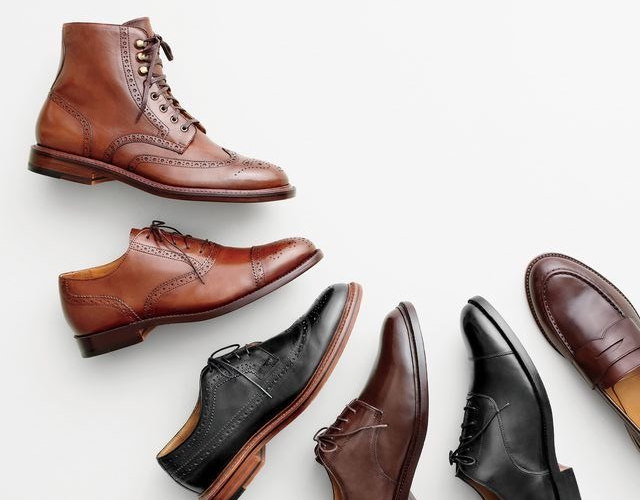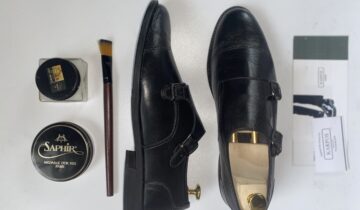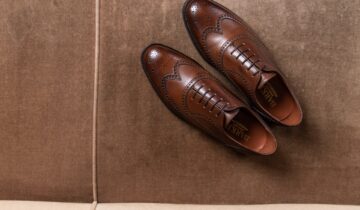Having a superb pair of dress shoes is not a luxury; it’s a necessity. Even sneaker and hoodie guys will occasionally need to suit-up, and opportunity favors the prepared.
This guide will help you make wiser shoe purchasing decisions. Once you understand the available options, you’re already halfway there toward looking your best at any event.
The Oxford

Oxfords, the most basic and timeless of dress shoes, are an excellent starting point. The versatile Oxford shoe can be dressed up or down for formal and daily wear.
A Little History
These shoes gained popularity in 1800 among college students, particularly at Oxford University. At the century’s turn, students wanted a modern low-top version of the shoe, as they deemed the half-boot style of traditional Oxonian shoes outdated.
How to Identify
The most recognizable trait of an Oxford shoe is its “closed lacing”; this means that the shoe’s facing is attached beneath its vamp. This arrangement provides a slim silhouette that hugs the foot’s contour.

How to Wear
Oxfords are chiefly popular because of their minimalism and their ability to pair with any outfit.
- For everyday wear, there’s a wide range of colors from brown to blue to dark red to green, in both leather and suede.
- For business attire, dark brown, cordovan, English tan, and black leather are your safest choices.
- If you’ll be pairing Oxfords with a tuxedo or other formal wear, black patent leather is your best bet.
The One Piece Oxford
The one-piece Oxford is a variation on the classic oxford. It’s constructed of a single leather piece rather than various pieces sewn together, and it has a single seam. This limited stitching provides a sleek and sophisticated look that adds to the shoe’s simple, no-nonsense style.
The Derby

The Derby is similar to the Oxford, but it’s a more casual dress show.
A Little History
The Derby shoe, also known as the Gibson or the blucher, was a sporting and hunting boot circa the 1850s. At the turn of the 20th century, they became appropriate for going out into town.
How to Identify
Derbies are often miscategorized as Oxfords since their shapes are very similar and their differences are very subtle. The key difference between Derbys and Oxfords is that the Derby shoe has its facing attached on top of the vamp. This is called “open lacing” and allows for a wider fit.
This wider, comfortable fit winks at the Derby’s sporting roots and solidifies the Derby shoe’s positioning as more casual than the Oxford.

How to Wear
You can wear and style Derby shoes the way you would Oxfords. However, Derbys are typically more casual, so you wouldn’t want to wear them with a formal suit. Chinos and rolled jeans, however, would go pair with these shoes.
The Monk Strap

A laceless shoe that is more formal than the Derby but less formal than an Oxford.
A Little History
This shoe takes its name from the monks who originally donned them, as this simple closed-toe design provided greater protection than their traditional sandals.
How to Identify
A Monk Strap is similar in shape and construction to an Oxford, but instead of an eyelet closure, it has a wide swath of leather fastened across the front of the shoe. This wide strap is fastened with either a single or double-buckle closure.

How to Wear
This classic alternative to laced dress shoes adds a certain panache to any outfit.
- The monk strap is now regarded as a very versatile shoe that can be worn with cuffed jeans or the most dapper of suits.
- Monk straps attract attention and may at times become the focal point of an ensemble.
- Monk strap shoes are often crafted out of leather or suede and will sometimes have decorative brogueing.
The Loafer

The loafer is a moccasin-inspired shoe that is known for its slip-on style.
A Little History
The original loafer was a casual house slipper made for King George VI of England. It was neither acknowledged nor popular as a casual shoe until it came to the U.S. in the 1930s. It wasn’t until the 1960s that American businessmen and lawyers began wearing loafers with suits.
In 1966, Gucci introduced the bit loafer, which features a metal strap (in the shape of a horse’s bit) across the instep. Gucci’s innovation further elevated the loafer’s status as formal footwear — or at least confirmed that this was not strictly casual.
How to Identify
Loafers often have a saddle — a decoration that might be a plain strap, a strap with a slit (as with penny loafers), or a metal ornament. Tassels or a kiltie might hang from a saddle, while the minimalist loafer (the Venetian) has an exposed vamp without embellishment or ornamentation.
A signature characteristic of loafers (especially those more akin to a moccasin than a regal slipper) is an elevated seam that runs along the toe.
A casual variant of the loafer is the driving moccasin or driving shoe. These are often made of softer materials, are less structured, and have soles and heels made for wearer comfort while driving.

How to Wear
Wear clean Venetian loafers or embellished loafers with suits for formal settings. You can also opt for casual styles with rolled jeans.
The Dress Boot

The dress boot is a short lace-up boot. It is constructed like an Oxford, but with a longer shaft.
A Little History
This shoe style’s roots in the Victorian era, when men had limited footwear options. The dress boot quickly became an acceptable choice for formal daywear, and it still remains an attractive alternative to standard dress shoes today.
How to Identify
A dress boot is constructed like an oxford, and is very often the same shape but with a longer shaft. This short, lace-up boot may feature wingtip brogueing on the toe and along its seams.
Michelle Tirronen, Ties.com Studio
How to Wear
When is a boot dressy enough to be worn with a suit? It should be sleek, not too chunky, have thinner laces, and its soles should immediately distinguish the boot as a high-top dress shoe. Lug soles and commando soles will rarely be appropriate (though there are exceptions.)
- If the boots are made of fine leather, they can be brown or black or almost any other, so long as they complement the suit.
- Unless you are a styling expert, assume that a suede dress boot is a contradiction (though it need not be).
The Chelsea Boot

The Chelsea boot is a versatile laceless ankle boot.
A Little History
The Chelsea boot originates from Victorian England, reputedly created by the Queen’s bootmaker, J. Sparkes-Hall. These boots became the practical alternative to rigid Victorian boots of the age and were quickly adopted by equestrians.
Chelsea boots experienced a strong, permanent revival in the 1960s when The Beatles wore them as part of the British Mod look.
How to Identify
These ankle-length boots have rounded toes, low heels, and elastic gussets on the sides. Because of these elastic gussets, one can pull on and slip off the shoes with ease, without compromising the refined silhouette of a laced boot. In fact, the absence of laces contributed to Chelsea’s slim, clean shape.
In dressier versions, the vamp and quarters are made from a single piece of leather, which keeps stitching to a minimum for a tidy look.
How to Wear
Classic Chelsea boots don’t have decorative flourishes or embellishments. Their simplicity puts them in a class all their own: jeans get an upward lift, and traditional suits gain an edge. If you purchase suede Chelsea boots, wear them only as part of a casual or smart-casual ensemble.
The Chukka Boot

A lace-up boot with only two to three eyelets on each side.
A Little History
Chukka boots originate from the polo sport: a “chukka,” a segment of seven minutes, is the unit of time by which polo matches are measured; a match will consist of four, six, or eight chukkas.
Some say chukkas resemble shorter versions of the boots worn by polo players. People also say that Chukkas are intended to be comfortable after-game footwear for polo players–like the original Uggs were for surfers.
How to Identify
Chukkas are ankle-length boots with few eyelets. The absence of many eyelets and the short shaft allow for a snug fit that won’t disrupt the shape of one’s trouser legs. Also, Chukkas have a rounded toe, minimal stitching, and open lacing (similar to the derby). They are traditionally made of soft suede, but there are now many versions from which to choose.
Desert boots are a much more casual, rubber-soled version of the Chukka boot.
How to Wear
These are the most casual shoes we’ll discuss in this article. Chukkas are not appropriate for formal attire, though pairs made of high-quality leather can complement a smart-casual ensemble. Both chukkas and desert boots are exceptional for smart-casual.
Dress Shoe Toe Styles

When making an investment in quality footwear, take note of the details, and abide by the one golden rule: the toes of your dress shoes should be rounded, and never squared or pointy.
There’s a time and place for pointy and squared toes, but not on dress shoes.
Plain Toe
Plain toe shoes are as simple as it gets. The vamp is unadorned, and the resulting look is clean and unassuming.
Cap Toe
Cap toes feature a horizontally stitched line across the vamp that “caps” the toe. In most cases, a separate piece is stitched over the vamp. But sometimes, the cap is accomplished by a decorative stitch across a single piece.
Split/Apron Toe
The split toe, otherwise known as the apron toe, features a seam that starts at the middle of the toe, runs around the shoe, and ends at the middle of the heel. This toe style is more common in casual shoes.
Medallion
The medallion style has a plain toe, with hints of brogueing on top of the toe.
Wingtip
This toe style has a winged cap that peaks in the middle of the toe. Wingtips often feature brogueing in the center of the toe and along the seam of the cap.
Brogueing
Any dress shoe style can have brogueing. Brogue simply refers to the decorative perforations in various patterns.
Originally, the tiny holes were intended to allow water out of shoes when crossing the wet terrain. Brogueing is most often seen on Oxford, Derby, and Monk Strap shoes in four toe cap styles: full brogue, longwing brogue, semi-brogue, and quarter brogue.

Full Brogues / Wingtips
Also known as wingtips, the wing-shaped cap extends around to the outside of the toes.
Semi-Brogues
Semi-brogues, also known as half brogues, feature broguing along the seam of the cap toe as well as some decorative broguing on the center of the cap toe. This is more subtle than a full brogue.
Quarter Brogues
The most reserved of the lot, the quarter brogue simply features decorative broguing along the seam of the cap toe, with no decoration on the center of the cap toe.
Longwing Brogues
Longwing brogues are most common on the derby shoe. The shoe’s brogued wingtip cap continues along the side of the shoe all the way to its center seam in the back.
Take Your Pick
A signature pair of well-made dress shoes is an essential possession. Choose a well-crafted pair, and choose wisely.
Ideally, your choice expresses your personal style and fits with the clothes you typically wear. You can add uniqueness and dimension to them with creative lacing methods or colorful laces.
Investing
Not everyone can spend a fortune on dress shoes. Take into consideration how often you will be wearing them, and where you’ll be wearing them. There’s no need to break the bank if you’ll only wear dress shoes occasionally at weddings, funerals, etc. But if you’ll be wearing dress shoes as part of your daily professional ensemble, we suggest spending a bit more than you’d think too. Regular wearers who dress to impress should spend as much as one can comfortably afford to spend. Consider a well-made pair of dress shoes as a small investment.
The graphic below was designed for your convenience, and we welcome you to share it.






 No products in the cart.
No products in the cart.